Volunteering with Leatherback Sea Turtles in Galibi, Suriname
Volunteering with Leatherback Sea Turtles in Galibi, Suriname
Jeremy Hance, mongabay.com
July 8, 2008
|
|
The northern coast of Suriname is one of the best places in the world to view the largest turtle, the marine Leatherback. Watching the turtle rise out of the tides onto the beach gives one the sense of meeting something ancient, rare, and more sea-monster than marine turtle. Yet, if I call it a sea-monster, I do not mean that it is frightening or ugly: far from it. But it is mysterious, terrible, and wondrous.
Leatherbacks have a one-of-a-kind natural history. This critically endangered reptile is the only species left in its family of Dermochelyidae. Unlike other marine turtles, it does not have a proper shell; rather a carapace, which is connected directly to the rest of its body. They feed almost solely on jelly fish and travel further than any other marine turtle—across entire oceans—migrating annually for food and to lay their eggs, and prove unafraid to enter the cold waters of Norway or Chile. They also hold the record for the deepest dive of marine turtles, plunging to depths of 1,200 meters to feed.
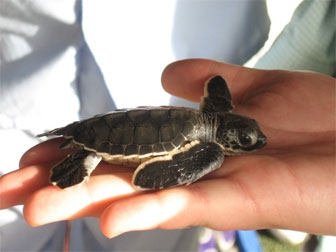 Green turtle hatchling. Scientists estimate 1 in 1000 will survive to adulthood. Photo by Tiffany Roufs. |
Scientists estimate that only 1 in 1000 Leatherback hatchlings survive to adulthood. Since 1980, 80% of the female population has been lost. Threats include drowning in fishing nets, longlines, and fishing traps. They are also crushed by coastal dredges. Important nesting beaches are commonly lost to development and tourism. Historically, turtle eggs have been eaten by many local populations, and the poaching of these eggs is still a very important problem, especially for the Pacific population. Pollution and debris have also taken their toll.
Being up-close to the world’s largest, fastest, and deepest diving turtle can be a mystical, spiritual experience. It is a lifetime moment, and hopefully one that will get you thinking deeply about the role of humans on the global environment. This is an animal that survived the demise of the dinosaurs, but may not survive us.
GALIBI
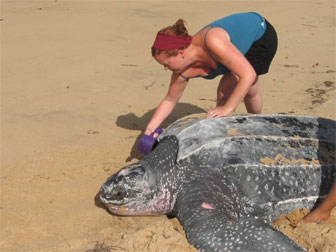 Checking the Leatherback for tags. It is rare for marine turtles to lay during the day. Photo by Jeremy Hance. |
Galibi is a Nature Reserve devoted to the conservation of marine sea turtles, most importantly the Leatherback and the Green Sea Turtle, though the Olive Ridley and Hawksbill can sometimes be seen there as well. The Reserve is a long stretch of beach, where turtles annually make their nests, bordered by dense jungle and mangrove. It is a beautiful and unique place.
The Reserve lies at the mouth of the Marowijne River, facing the Atlantic Ocean and with a good view of French Guiana. Two Amerindian villages are nearby—and deserve a visit. Most of the workers at the Galibi Reserve are from these villages.
The site is co-managed by STINASU and Suriname’s Nature Conservation Division. STINASU is a conservation organization that receives part of its funding from the government of Suriname and part from tourism.
THREE VISITING OPTIONS
Overnight Trip
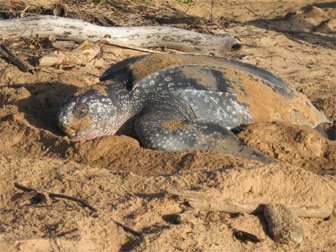 Leatherback sea turtle. |
All trips occur during turtle-laying season: between February and August.
Several tourist companies in Suriname can set-up an overnight trip to see the marine turtles of Galibi. Almost every other night of our two-week trip, tourists were on the beach scouting for turtles. With this option, you usually stay in the local indigenous village.
You’ll have a good chance of seeing a Green or Leatherback turtle on an overnight trip, but it’s not 100% guaranteed. You would be very lucky to see hatchlings. If time is a constraint this is not a bad way to see these magnificent animals, but a longer tour will provide a greater chance to truly appreciate these animal unrushed.
Price: approximately $250 US
Week-long trip with Oceanic Society
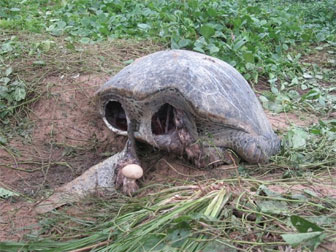 Carcass of a green marine turtle that was killed by a jaguar the night before. The next evening the jaguar would drag the whole carcass into the jungle. |
This is a guided 9 day tour, including travel days from Miami/Paramaribo and back. With this trip you will have your own guide, who is a researcher or an employee of the Oceanic Society. You will have the chance to spend five days working with the marine turtles. Depending on the dates of your trip, you will most likely see Leatherbacks and Greens, as well as hatchlings. In fact, you will probably see a lot of them.
You will be fed very well, lodged well, and have a great guide who is devoted to giving you a wonderful experience. If you have the money, this is a great way to experience the majesty of these turtles up-close.
2009 price: $2,890 US (IAF Miami)
Two week volunteering with STINASU
This is the choice my wife and I picked. At times, it proved difficult, but all-in-all we had an amazing experience and wouldn’t trade it for the world.
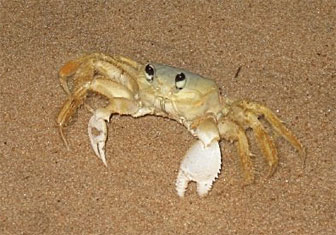 The ubiquitous ghost crab. They are one of many predators of turtle hatchlings. |
For those with ample time, a lot of patience, little money, and who don’t mind ‘roughing-it’ this may be an option to look at (if one could ever call sitting on a beach for two weeks ‘rough’). You’ll spend two weeks sleeping in what is basically dorm-quarters, cooking your own food (which you purchase in Paramaribo in a shopping-spree-like experience), and walking the beaches in the morning and at night looking for turtles.
The largest caveat with this experience: it is imperative you realize that the workers speak very little English and much of the time you are essentially ‘on-you-own’. We were fortunate to be in Galibi while an American grad student was doing work, so we were able to learn a lot about the turtles from her and pretty much shadowed her while she worked. Our experience would have been much less if she hadn’t been there. If you are thinking of doing this trip, I would suggest contacting STINASU and seeing if there are any English-speakers doing research during the time you are there.
If you speak Dutch then this is not a concern. A few of the local workers do speak some English and they are very friendly, but communicating anything ‘complex’ is very difficult.
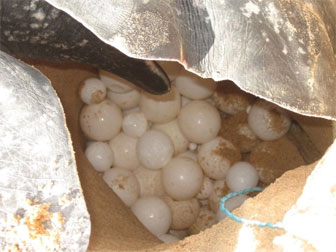 Leatherback eggs in nest: small eggs are called spacer eggs and do not produce young. The Leatherback lays approximately 100 eggs each time. Photo by Tiffany Roufs. |
Also, while this is essentially a volunteering trip, you will have a lot of free time, and the work is hardly difficult (although late-nights, early-mornings can be tiring). In addition, I would also suggest asking STINASU ahead-of-time if there are any special projects you can work on while out there, for example, collecting garbage on the beach or any maintenance-type work.
The station has a radio, but essentially you are in the wilderness. There is no Internet access or phones or anything of that sort. I probably wouldn’t recommend doing this trip alone, as you will most definitely go stir-crazy unless you are very rare traveler who is accustomed to weeks with little company.
Cost: approximately $400 US (plus added expenses for two weeks worth of food)
FLORA AND FAUNA
Aside from the many opportunities to get close to Leatherback and Green sea turtles, as well as their hatchlings, there is a lot more to explore in this unique ecosystem, which combines jungle, beach, and mangrove.
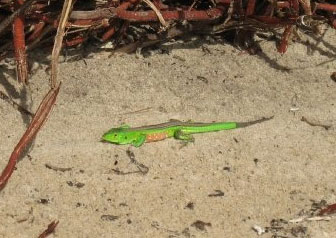 Colorful green garden lizard (Ameiva ameiva) in the mangroves. Photo by Tiffany Roufs. |
A troupe of squirrel monkeys visited the camp daily, feeding on the plentiful and vibrant cashew fruit. One could watch them for hours—and we did. Black vultures, ghost crabs, and various lizards are ubiquitous. Several species of kites and hawks are in the area. Bats come out at night. Several times we saw opossum (one night we saw two of these marsupials fighting on a cactus). If you venture into the jungle—which you should not do without a guide—you’ll have a chance to see (or hear) other types of monkey, frogs, birds, and various insects.
As with any trip into the jungle, you’ll be very lucky to see large mammals. However, in a strange meeting between terrestrial and marine environments, jaguars regularly kill green turtles on the beach. While we were there, a jaguar killed a green turtle: we did not see the jaguar (though one of our guides did) but we were able to explore the kill and see the massive cat’s footprints.
GEAR AND PREPARATIONS
No matter what you will want to bring strong sunscreen and a lot of it. It is difficult to find any sunscreen in Suriname above SPF 15. You will also want to bring your camera, binoculars, rain jacket, insect repellent, broad-brimmed hat, some pocket money, and an extra pair of clothes even if only staying one night.
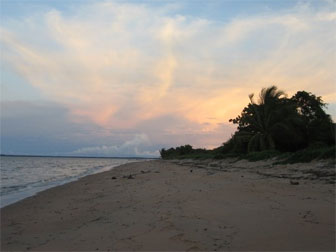 Galibi at sunset. Photo by Tiffany Roufs. |
If you are staying for the week to two-weeks, you will undoubtedly have a lot of down-time. A lot. And if from Europe or America you may find it a bit difficult to adjust to long sunny days with no Internet, TV, or distractions, and you may find yourself feeling a bit stir-crazy. Best advice: relax. I suggest bringing ample reading material (my wife read the entirety of The Brothers Karamazov while there). But even if your book is long, bring more than one. Also, I would suggest packing playing cards and small travel board games. My wife and I played a fortnight tournament of travel Scrabble.
If staying the full two weeks through STINASU you will need to buy food in Paramaribo before leaving. There is no refrigeration. I suggest foods that are hearty and easy to cook such as pasta, rice, beans, etc. Peanut- butter sandwiches is an easy and satisfying breakfast. You should bring any coffee, tea, soda, juices as well. Also, beware that ants will probably at some point or another invade your food—once they discover your precious stack of cookie, you can either throw-it, dig them out, or realize its just extra protein and snack-away.
The lodge has rain water for cooking and drinking: it is safe. However if you prefer you can buy bottled water in Paramaribo. Also, if you want alcohol you should get it ahead of time. With the other tours food will be provided (but not alcohol).
Also, do you research on the turtles. Please remember that you are in their space and that this is a vital time for them. In other words, no flash cameras and flashlights should be red (the turtles don’t see that light). Also speak quietly and keep a distance from the turtles; loud noises and lots of movement can cause them to spook and head back into the ocean. Only approach them with your guide and only do as your guide requests. If you are volunteering you will probably have the opportunity to touch adults and handle hatchlings, remember to listen to your guide before doing so.